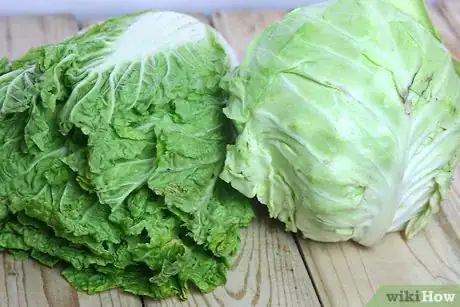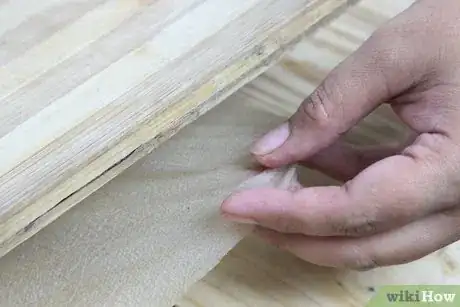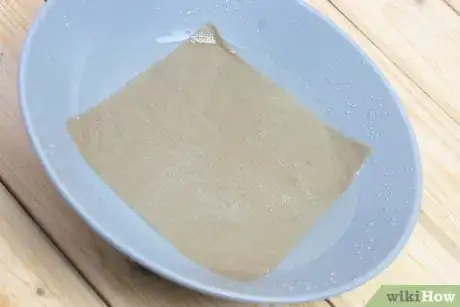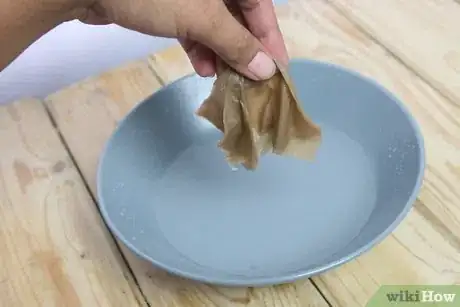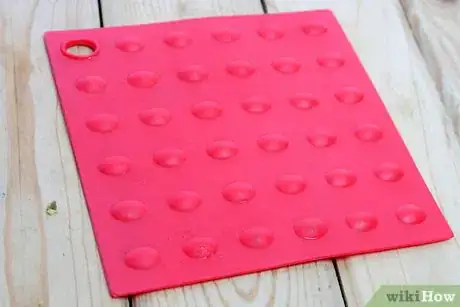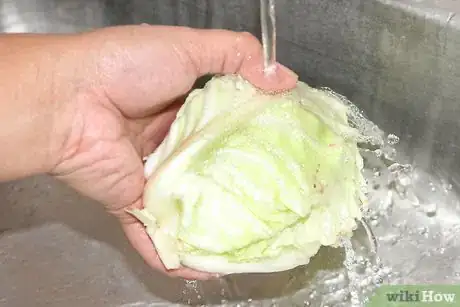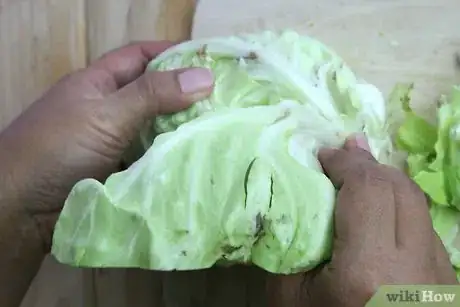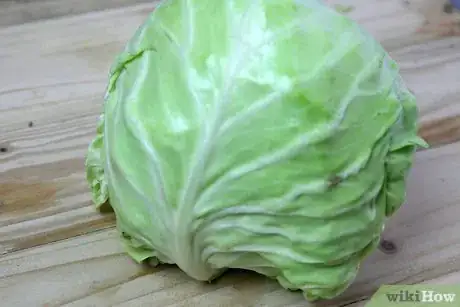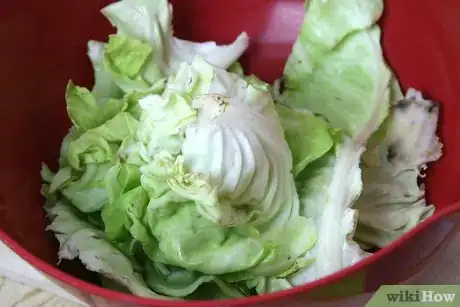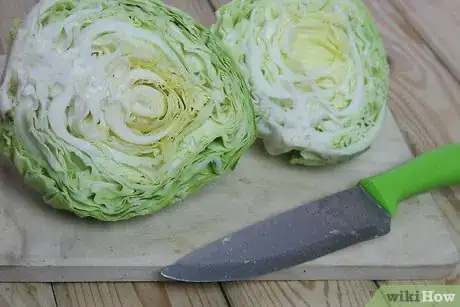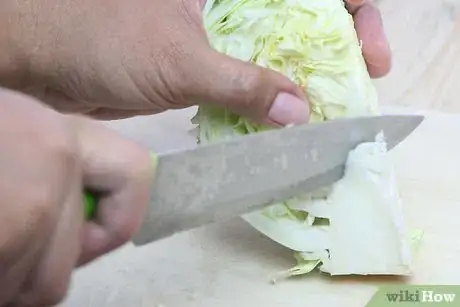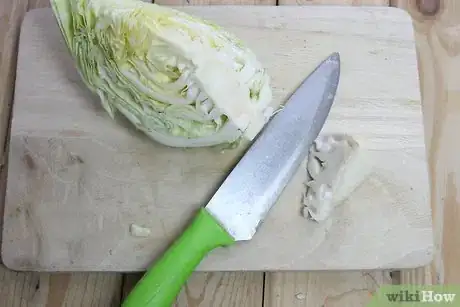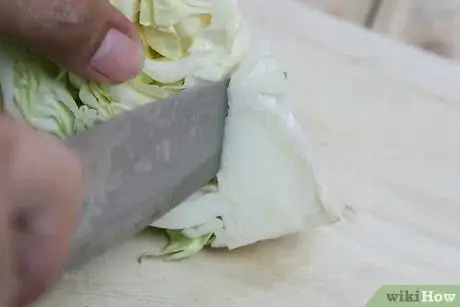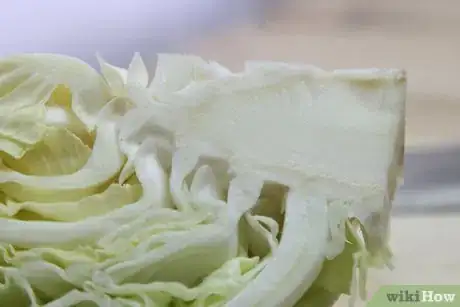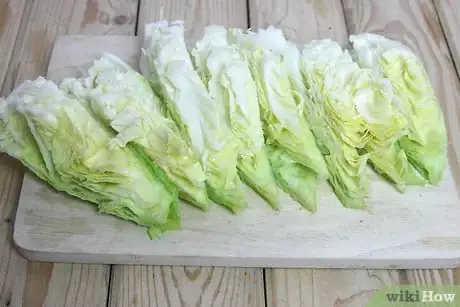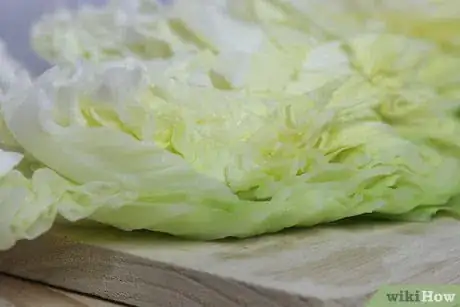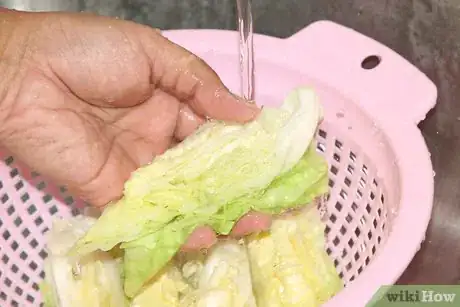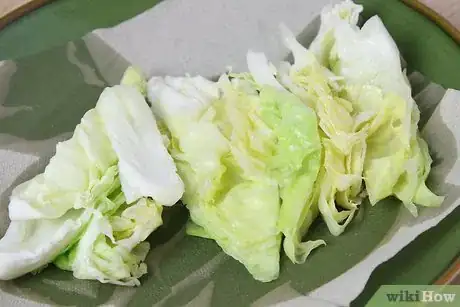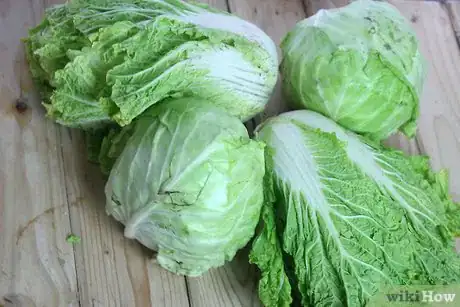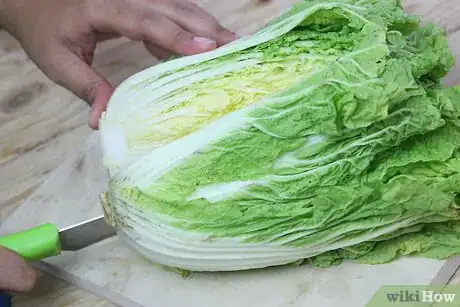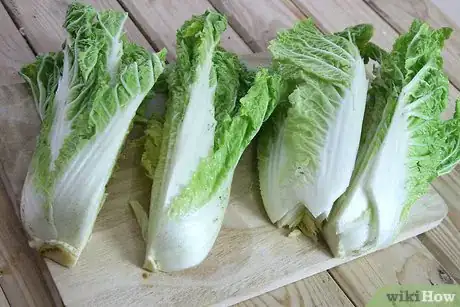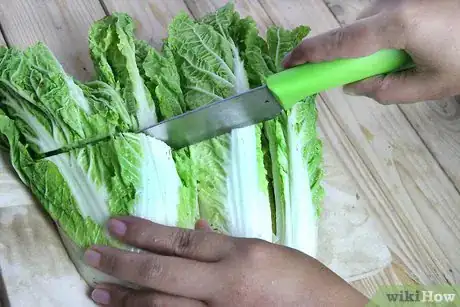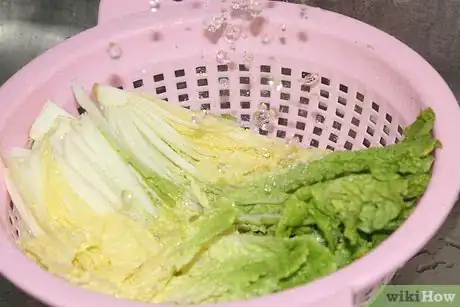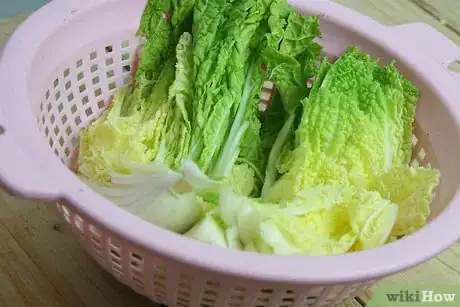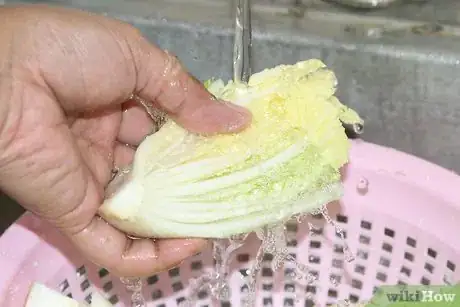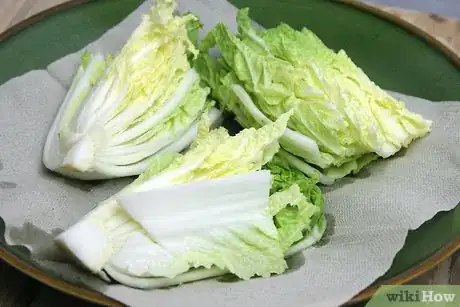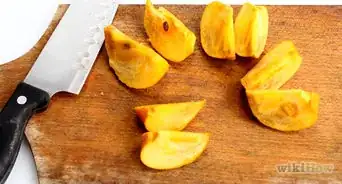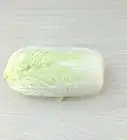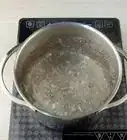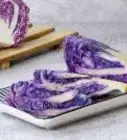X
wikiHow is a “wiki,” similar to Wikipedia, which means that many of our articles are co-written by multiple authors. To create this article, volunteer authors worked to edit and improve it over time.
This article has been viewed 72,595 times.
Learn more...
There are multiple ways you can cut cabbage. Some recipes, especially those that require you to roast or grill cabbage, will ask you to cut the vegetable into wedges. All you have to do is to pick the right cabbage and learn how to cut it into wedges, using the correct technique for cutting round or long cabbage.
Steps
Method 1
Method 1 of 3:
Before You Begin: Preparations
-
1Choose a fresh head of cabbage. Fresh cabbage can be identified by its crisp leaves. The leaves should be tightly packed for round varieties and only slightly loose for long varieties. Additionally, there should be no signs of browning and the stem should look fresh rather than dry.
- Green cabbage is a round variety. Its leaves should be tightly packed together and dark green on the outside. The inner leaves will be a pale green.
- Red cabbage is another round variety, and its leaves should also be tightly packed together. The outer leaves are especially tough, and all of the leaves should have a reddish purple color.
- Savoy cabbage is a round variety, but its leaves are crinkled and fairly loose when compared to green and red cabbages. The leaves can range in color from dark green to light green.
- Napa cabbage is tall and skinny, with loose, pale green leaves.
-
2Use a stainless steel knife. Use a sharp, stainless steel cooking knife with a smooth, sturdy blade.
- Only use stainless steel knives. Do not use knives made from other metals, because the natural chemicals within the cabbage can react with other metals. As a result, both the cabbage and knife can turn black.[1]
Advertisement -
3Keep the cutting board stable. Spread a moist paper towel in between the cutting board and the counter to prevent the cutting board from sliding around.
- Soak the paper towel in water and squeeze out the excess moisture. This gives the towel just enough tension to prevent it and the cutting board from sliding around.
- Do not let the towel stay soaked, though, since a soaked paper towel will be too slippery.
- Note that this may not be necessary if you are using a no-slip silicone cutting mat.
-
4Clean your working area and supplies. Make sure that your hands, the knife, and the cutting board are all clean before you begin.
- Use warm water and soap to clean your hands and all the supplies used for cutting the cabbage.
- Rinse the knife and cutting board with clean, running water to remove all soapy residue. Wipe dry with clean, dry paper towels.
- Do not clean the cabbage yet. The cabbage should be rinsed after you cut it, not beforehand.
Advertisement
Method 2
Method 2 of 3:
Cutting Round Cabbage
-
1Know which varieties of cabbage this applies to. Round cabbages have tightly packed leaves and are spherical in shape. Common varieties include green cabbage, red cabbage, and savoy cabbage.
-
2Remove the outer leaves. Use your hands to peel off any tough or damaged outer leaves from the head of cabbage.
- Round heads of cabbage with tightly packed leaves have thick outer leaves. Even if these leaves are in good shape, you should still remove them before cutting the cabbage, since they tend to be tough and not especially appetizing. This is especially true if you plan on eating the cabbage raw.
- Any wilted or discolored portions must also be removed.
-
3Cut the cabbage head in half. Place the head of cabbage on its core end and slice it in half lengthwise, from the top center straight down and through the core.
- If you cut the cabbage open and suspect that worms or insects have caused damage to the interior, you can still use the cabbage. You need to soak it in salt water for 20 minutes before continuing any further, though.[2]
-
4Cut the halves into quarters. Place each half cut-side down and cut in half lengthwise once more, creating quarters.
- You can stop here, but the wedges may still be too wide for use in many recipes.
-
5Remove only part of the stems. Flip the quarters over to reveal the cut sides. Cut a wedge at the bottom into the core of each quarter. Only cut away part of the core, however, not all of it.
- Keeping part of the core connected to the leaves will make it easier to keep the layers of leaves in each core held together.[3] If you cut out the core completely, the leaves are likely to separate. The cabbage will still be edible, but the wedges will be ruined.
- While looking at the core, cut a triangular wedge into the top portion of the core but not all the way through it. Slice a large portion of the wedge away while leaving a thin layer behind.
- If you are anxious about cutting away some without cutting away too much, you could also simply leave the core intact. The core is tougher than the leaves, but it becomes tender and edible once cooked.
-
6Cut into eighths, if desired. If you want smaller wedges, place each quarter whole-side-down and cut the quarter in half lengthwise, from the top tip through the remainder of the bottom core.
- This is usually the preferred wedge size. If you cut the wedges any smaller, you run the risk of causing them to break apart.
-
7Wash the cabbage. Gently rinse each wedge of cabbage under cool running water. Drain dry on clean paper towels.
- The inside of a cabbage is usually clean, but you should still rinse it under running water just to be on the safe side.
- Hold the cabbage wedges over a colander in case any of the leaves separate and fall off under the pressure of the running water. The colander will catch the leaves while letting the water pass through.
- You do not need to scrub the leaves when cleaning them.
- To dry the wedges after rinsing them, lay them out flat in a single layer on several layers of dry paper towels for a few minutes. The excess water should fall off on its own.
Advertisement
Method 3
Method 3 of 3:
Cutting Long, Skinny Cabbage
-
1Know which varieties of cabbage this applies to. Long cabbages have somewhat loose leaves and are somewhat rod-shaped. The most common variety is the napa cabbage.
-
2Remove the outer leaves. Use your hands to peel away damaged leaves on the head of cabbage.
- Tall heads of cabbage with loose leaves lack the thicker outer leaves that round heads have. As such, you only need to remove leaves that are wilted, discolored, or otherwise damaged.
-
3Cut the head in half lengthwise. Place the head of cabbage on its side and cut in half lengthwise, from the top of the head through the core.
- You do not need to remove any part of the core when cutting a long cabbage. In fact, for wedges, it is actually beneficial to keep the core. The core holds the leaves together, which means that the wedges will be able to remain intact, as well.
-
4Cut each half in half again. Flip each half over so that the cut-side faces the cutting board. Cut in half lengthwise once more, creating quarters.
- Since these cabbages are tall and skinny, you probably will not be able to cut wedges that are any skinnier than this without causing the leaves to fall off the core.
-
5Cut crosswise, if desired. You can stop after cutting the cabbage into quarters, but if these pieces are too long for you, cut each quarter in half crosswise to reduce the length of each wedge to half.
- Note, however, that any wedge not attached to the core is more likely to fall apart. Even if the wedge gets destroyed, though, the cabbage will still be edible.
-
6Rinse the cabbage. Gently rinse each wedge under cool, running water. Drain dry on layers of clean paper towels.
- Even though the inside of a cabbage is usually clean, you should still rinse it under running water just to be safe.
- Hold the cabbage wedges over a colander in case any of the leaves break off under the pressure of the running water. The colander will catch the leaves while letting the running water pass through.
- You should not scrub the leaves when cleaning them.
- To dry the wedges after rinsing them, lay them out in a single layer on a few dry paper towels for several minutes. The excess water should drain off on its own.
Advertisement
Things You'll Need
- Cabbage
- Cutting board
- Paper towels
- Water
- Soap
- Stainless steel knife
- Colander
References
About This Article
Advertisement
